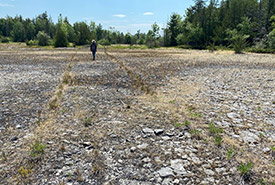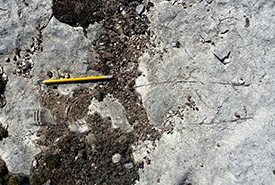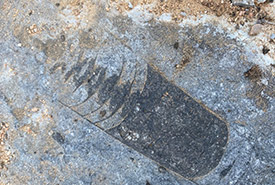The fossils of Camden East Alvar

A particularly exposed section of the Camden East Alvar, an NCC property just west of Kingston, Ontario. (Photo by NCC)
Doing field work in the middle of the summer can be hot, but doing it on an alvar feels even hotter.
An ecosystem formed with little to no soil on top of limestone bedrock, alvars typically have large areas of low-lying vegetation and exposed bedrock. This limestone bedrock absorbs and retains the heat from the summer sun, much in the same way that asphalt does. If you’ve ever felt the heat radiating from a parking lot in the middle of summer, you’ll know what an alvar can feel like.
Yet one of the (many) differences between asphalt and limestone is that limestone is millions of years old. What is now the bedrock of much of southern Ontario was once the floor of an ancient sea, home to the ancestors of many of the species we see on Earth today. Limestone, a sedimentary rock composed of calcium carbonate from shells and skeletons, is perfect for preserving fossils from many of these ancient species. Most of the time, this limestone bedrock and the fossils within it are covered by large amounts of soil and vegetation, but on alvars, they are much closer to the surface.
At the Camden East Alvar, there are large amounts of exposed limestone with little to no vegetation. On my first visit to the property, a small fossil was pointed out to me, with the promise that there would be more if we looked for them. We spent a few minutes looking, finding a few other small ones, as well as a large piece of differently coloured rock. Could it be a fossil? At about 60 centimetres in length, it would be the largest that we had found. It was like detective work; every time there was an irregularity in the rock, we would stop to look at it. Was it a fossil? What animal did it belong to?

One of the largest fossils that we found. The first one we found was slightly larger, yet not as visible. (Photo by NCC)
In subsequent visits to the property, we became more certain of what was fossil and what was just rock. Fossils were typically a much darker grey than the rest of the limestone, and they had clear, straight-cut boundaries. Using this criteria, we were able to go back to the large piece of dark rock we had seen on the first day and confirm that it was indeed a fossil! In fact, it was likely the fossil of a cephalopod, the family that, today, squid and octopus belong to!
As the summer progressed, the temperature increased; there have been many hot days that we’ve spent working on the alvar — mapping invasive species, maintaining trails and performing species-at-risk surveys. Yet even on the hottest days, we always seem to find the energy to spend a bit of extra time out in the sun, hunting for fossils. Now that we know what to look for, we see them everywhere; every slight discolouration in the rock draws my attention, even if it’s nothing more than a shadow. We’ve found fossils that look like corals, a few that look like small pieces of shells, and a lot more cephalopods!

One of the smaller cephalopod fossils that we found, this one about the width of a coin. (Photo by NCC)
Each time we find a new fossil, it’s like a time capsule into life millions of years ago. There’s always a rush of excitement from stumbling upon them, acting as a distraction from whatever else we’re working on. It’s amazing to think that these dark lines we see in the rock are the remains of prehistoric creatures, and to imagine the world as they would have seen it!
Note: If you are hiking near fossils, please ensure that you do not leave the marked trail and do not attempt to extract the fossils from the rock, as this can damage their sensitive ecosystems.




